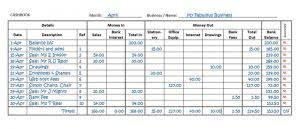Content
- Table 2 Correlation Coefficients For Liquidity And Profitability Ratios In Croatian Surveyed Smes Over The Period 2010
- What Is The Normal Order Of Liquidity?
- What Are Some Examples Of Current Assets?
- Definition Of Term Order Of Liquidity
- How Do You Label A Balance Sheet?
- Balance Sheets Revision Quiz
- Efrag Draft Comment Letter On The Classification Of Debt With Covenants
- Merchandise Inventory

A higher number is better since it means a company can cover its current liabilities more times. An increasing operating cash flow ratio is a sign offinancial health, while those companies with declining ratios may have liquidity issues in the short-term.

Cash and cash equivalents, which might consist of cash accounts, money markets, and certificates of deposit . Current assets are order of liquidity all the assets of a company that are expected to be sold or used as a result of standard business operations over the next year.
Table 2 Correlation Coefficients For Liquidity And Profitability Ratios In Croatian Surveyed Smes Over The Period 2010
Lessons learned from previous financial crises point to the necessity for maintaining supply chain integrity, and ensuring that suppliers have access to liquidity in order to produce goods and services. Suppliers found value in enlisting in these programs to use the cash from receivable conversions as working capital. Like many companies, suppliers faced liquidity shortages during the past year due to pandemic-related economic upheaval. In some cases, excess demand for certain goods overburdened suppliers’ production capacity and drained them of working capital. In other cases, lower demand for goods caused income shortfalls. And physical disruptions in the manufacturing or delivery of goods, in some cases, delayed payments.
- Current assets are important to businesses because they can be used to fund day-to-day business operations and to pay for ongoing operating expenses.
- To clear short term liabilities we bank on assets that can be speedily converted to cash.
- Personal net worth is the difference between an individual’s total assets and total liabilities.
- Inventory is removed because it is the most difficult to convert to cash when compared to the other current assets like cash, short-term investments, and accounts receivable.
- The policy of liquidity has a great impact on net income and profitability of S.M.E.s which can increase by minimising the costs of financing liquid assets or by maximising the return on excess liquid assets.
- Sometimes the rights, privileges and advantages of your business are worth more than all other assets combined.
- Deloitte refers to one or more of Deloitte Touche Tohmatsu Limited (“DTTL”), its global network of member firms and their related entities.
The Hausman test was performed to decide between a random effects regression and a fixed-effects regression. The Breusch–Pagan Lagrange multiplier was used to decide between a random effects regression and a simple ordinary least squares (O.L.S.) regression. The statistical data analysis was carried out using Stata software version 15.0. Information about how the expected cash outflow on redemption or repurchase was determined. For which the entity does not have the right at the end of the reporting period to defer settlement beyond 12 months. In addition to being a liquidity aggregator, FLUID is incorporating a smart order routing engine to enhance the ability of exchanges to fulfill orders.
What Is The Normal Order Of Liquidity?
By calculating and tracking different ratios of your company’s assets and liabilities, you can measure your business’ liquidity. This is necessary for spotting cash flow problems and checking if your business is in good financial health.
- However, the composition and quality of current assets is a critical factor in the analysis of an individual firm’s liquidity.
- In addition, our results indicate that the average value of quick ratio is 1.47 with a standard deviation of 2.75.
- So again to level set us all here, I think it’s important to just walk across here very briefly of what the order to cash process looks like for the sake of this presentation.
- Current assets contrast with long-term assets, which represent the assets that cannot be feasibly turned into cash in the space of a year.
Some of the most common ratios used to gauge the liquidity of a business is thequick ratio,current ratio, andworking capital ratio. So that’s the historical stuff or the right stuff really the real-time data. So to the answer, your question is it’s probably on the order of on a weekly basis, four to six hours. So the mechanical, so we’re providing data feeds to the bank, the bank sends back what the analogies are.
What Are Some Examples Of Current Assets?
The buyers first in line are likely to get in at the 90 cent price. The buyers in the middle or back of the line will likely be matched with sellers at the higher prices. This image, though not perfect, illustrates how slippage happens when you place a market order. It depends on how far back in the line you stand among all other investors who want to buy the same contract at the same time. A common problem is stock “obsolescence” – where inventories have to be sold for less than their cost perhaps because they are damaged or customers no longer demand them.

The issuing company creates these instruments for the express purpose of raising funds to further finance business activities and expansion. Liquidity ratios are a class of financial metrics used to determine a debtor’s ability to pay off current debt obligations without raising external capital.
Prepaid expenses could include payments to insurance companies or contractors. Current assets are important to businesses because they can be used to fund day-to-day business operations and to pay for ongoing operating expenses. Since the term is reported as a dollar value of all the assets and resources that can be easily converted to cash in a short period, it also represents a company’s liquid assets. Here, they are highlighted in green, and include receivables due to Exxon, along with cash and cash equivalents, accounts receivable, and inventories. Current assets include cash, cash equivalents, accounts receivable, stock inventory, marketable securities, pre-paid liabilities, and other liquid assets. Also known as the “acid test” ratio, this is a refinement of the current ratio and is a more conservative measure of liquidity.
Definition Of Term Order Of Liquidity
Idle cash is, as the phrase implies, cash that is idle or is not being used in a way that can increase the value of a business. It means that the cash is not earning interest from sitting in savings or a checking account, and is not generating a profit in the form of asset purchases or investments. The cash is simply sitting in a form where it does not appreciate.
- The financial forecasting tools are going to inform your revenue and your invoicing.
- We use money to purchase goods and services regularly, but in this lesson, we will take a closer look at money.
- Balance sheet substantiation is an important process that is typically carried out on a monthly, quarterly and year-end basis.
- Your investments also include money that you may be holding for a pension fund.
- As lowering liquid assets can result in a reduction of their sources of financing and costs of financing as well as in excess amount of liquid assets for investment, it has a positive impact on profitability of S.M.E.s.
- Besides his extensive derivative trading expertise, Adam is an expert in economics and behavioral finance.
- Your inventories are your goods that are available for sale, products that you have in a partial stage of completion, and the materials that you will use to create your products.
These solutions are suitable for organizations with a high volume of accounts and/or personnel involved in the Balance Sheet Substantiation process and can be used to drive efficiencies, improve transparency and help to reduce risk. Guidelines for balance sheets of public business entities are given by the International Accounting Standards Board and numerous country-specific organizations/companies. The Federal Accounting Standards Advisory Board is a United States federal advisory committee whose mission is to develop generally accepted accounting principles for federal financial reporting entities. One of the important steps in the accounting cycle when preparing financial statements is the adjusted trial balance. Discover more about the definition of the adjusted trial balance, including its preparation and the trial balance worksheet, and an example of this step in practice. The Generally Accepted Accounting Principles, or GAAP, are a specific set of guidelines created by the Financial Accounting Standards Board aimed at helping publicly traded companies create financial statements.
How Do You Label A Balance Sheet?
Your other fixed assets that lack physical substance are referred to as intangible assets and consist of valuable rights, privileges or advantages. Although your intangibles lack physical substance, they still hold value for your company. Sometimes the rights, privileges and advantages of your business are worth more than all other assets combined. These valuable assets include items such as patents, franchises, organization expenses and goodwill expenses.

Hence it is of great interest to improve the understanding of the time-dependent dynamics of the limit order book. In our analysis we find a broad distribution of limit order lifetimes. Around the quotes we find a densely filled regime with mostly short living limit orders, far away from the quotes we find a sparse filling with mostly long living limit orders. We determine the characteristics of those two regimes and point out the main differences.
Current assets would include cash, cash equivalents, accounts receivable, stock inventory, marketable securities, pre-paid liabilities, and other liquid assets. Balance SheetA balance sheet is one of the financial statements of a company that presents the shareholders’ equity, liabilities, and assets of the company at a specific point in time. It is based on the accounting equation that states that the sum of the total liabilities and the owner’s capital equals the total assets of the company. This study has provided empirical evidence of a negative relationship https://www.bookstime.com/ between liquidity expressed in terms of current assets to current liabilities ratio and S.M.E.s’ profitability expressed in terms of return on assets. Our findings indicate that managers should aim to keep as close to the optimal liquidity level as possible and try to avoid any deviation in order to maximise the profitability of an S.M.E. We have investigated whether there is a relationship between liquidity level, expressed in terms of current-assets-to-current-liabilities ratio and profitability, expressed in terms of return on assets.
Order of permanence in accounting is the order of arranging assets in order of their permanency, i.e. assets that are most permanent are shown first and least permanent assets are shown last. Similarly, long term liabilities are shown first and current liabilities are shown last. This ratio measures the extent to which owner’s equity has been invested in plant and equipment . A lower ratio indicates a proportionately smaller investment in fixed assets in relation to net worth and a better cushion for creditors in case of liquidation. Similarly, a higher ratio would indicate the opposite situation. The presence of substantial leased fixed assets may deceptively lower this ratio.
So the next step we’re going to assume that something pretty bad happens that the invoice ages out past 90 days. So what you thought was thought you’re a pretty good situation with $5 of positive liquidity. The next day you find out you’ve got $80 of negative liquidity. So this is that bucking-bronco – it’s one of those impacts that can be tough to predict, tough to forecast. And it’s important to keep these things in mind and to keep a close eye on your aging as one for instance. Accountants prepare many documents to provide financial status information to an organization’s stakeholders. Learn how to prepare the basic balance sheet, as well as the statement of cash flows.
Having an order of liquidity can also be helpful to understand a company’s key areas of cash generation. If a company doesn’t have enough immediate cash to cover all of their liabilities or repay investors, it’s important to know which assets they can sell and how long it might take them to generate the money. The excess cash or decrease in liquid assets should be invested as net profitability occurs. By using the model for calculating net savings through decreasing the amount of liquid assets, we calculate the net savings and find that the net earnings are 149,333.30 EUR.






